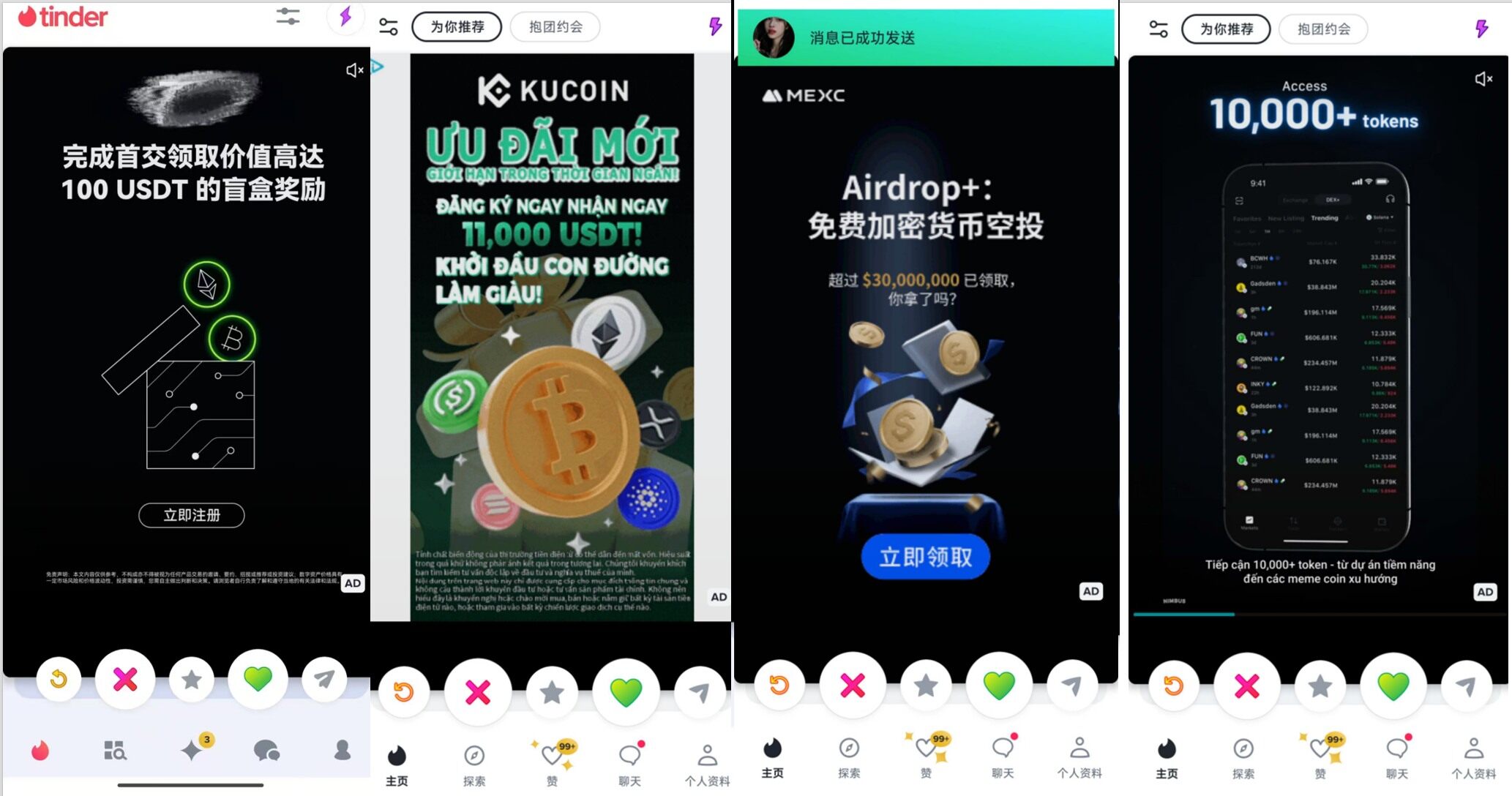Original | Odaily Planet Daily (@OdailyChina)
Author|Golem (@web 3_golem)
Late at night, after finishing a day of crypto trading, you lie in bed exhausted, opening Tinder to match with a stranger for a wonderful date. Suddenly, an advertisement from a crypto exchange pops up, stating "Complete your first trade to instantly receive xxx USDT reward." You can't help but sigh in disappointment. Unable to sleep, you open a video platform to watch an episode of your favorite series, but just as the plot reaches its climax, a 15-second ad interrupts—not for the Macau Grand Lisboa, but for a crypto exchange. At this point, you finally can't hold back and curse, "F**k you, crypto!"
Crypto exchanges are invading the daily lives of ordinary people through advertisements, and behind this is the growth ambition of CEX.

According to Binance's official disclosure, its global registered users on the platform are expected to exceed 250 million by the end of 2024, an increase of about 47% compared to 2023. While the results are encouraging, it also means that for top exchanges, the number of new users available in the industry has become saturated. To acquire new users, they must actively stimulate demand from consumers outside of crypto and extend their customer acquisition efforts into Web2.
Who is quietly advertising to us?
To satisfy the ambitions of exchanges, a lesser-known growth department is responsible for placing ads in our cyber lives—Paid ads.
"Within the exchange, we are a department parallel to BD, both responsible for user growth, but we engage with users through paid advertising," Hamburger (a pseudonym), who works in Paid ads at a certain exchange, revealed to Odaily.
"Traditional crypto users mostly interact with the exchange's BD, who not only connect with B-end project parties but also engage deeply with C-end communities, maintaining good relationships with KOLs, website owners, and rebate team leaders. Sometimes they even act as customer service representatives, helping ordinary users with their problems. Some BDs from large exchanges also grow into KOLs, leveraging their personal influence to amplify user growth."
However, as user growth in the industry hits a bottleneck, the role of BDs has become increasingly limited. The difficulty of reaching new users has grown, and maintaining existing customer relationships through differentiated strategies to outmaneuver competitors has become the daily routine for BDs.
Thus, when conventional user growth methods approach obsolescence, Paid ads have become a lifeline for user growth at exchanges.
The goal of Paid ads is to acquire qualified traffic or users (installations, registrations, transactions, leads) at the lowest/optimal cost through paid channels and to convert the advertising results into measurable business growth.
"We purchase advertising resources and placements on media platforms like the Apple Store, Google, TikTok, and Facebook, and based on the algorithms and audience targeting of these platforms, we bring some new users to our exchange," Hamburger explained.
Different growth methods also determine the size of the team. According to Hamburger, although Paid ads and BD are parallel departments, there is a significant difference in their numbers. "For example, in our exchange, there are no more than 20 colleagues engaged in Paid ads globally."
Although the team is small, it is still sufficient. Paid advertising can be divided into self-managed and outsourced. Self-managed means the exchange's Paid ads team collaborates directly with media platforms, uploading materials, building ads, checking results, and making real-time adjustments; outsourced means handing over the advertising work to an agency, which meets the needs of a small team but many advertising platforms.
The use of Paid ads in the exchange sector is not new; it has only been heavily invested in in recent years. According to insiders, Binance began experimenting with Paid ads in 2021-2022 but only started significant investments in 2024, while OKX ventured into this area even earlier.
"Medium-sized exchanges typically have an annual budget of about $2 million for Paid ads, while large exchanges will spend even more," Hamburger explained to Odaily regarding the budget for paid advertising, but he declined to disclose his exchange's annual budget due to confidentiality reasons.
However, regardless of the specifics, compared to the advertising budgets of Web2 giants, the investment from crypto exchanges is a drop in the bucket. According to public data, Google's advertising budget for 2025 is approximately $8.7 billion, while Amazon's is $31 billion, and Netflix's advertising spending in 2024 will exceed $1.7 billion.
Although there is a gap in profitability, this also indicates that for CEX, the user growth model through Paid ads is still in its early stages and not yet mature. "In theory, the demand for Paid ads from top exchanges is significant, and as long as the results are good enough, the budget can be limitless," Hamburger asserted confidently.

Ideally, $50 to acquire a new user
According to Hamburger, the ads they are currently running are indeed effective for new user growth. One of the advantages of Paid ads over BD is the ability to clearly calculate ROI (Odaily note: ROI stands for Return on Investment, measuring how much net profit can be generated for every dollar spent), allowing for the evaluation of the effectiveness of ads on different media platforms. If a platform's user demographic is younger and more receptive to crypto, then the advertising effectiveness will be better.
"Typically, the Apple App Store has better ad performance, while ads targeting mobile manufacturers perform poorly," Hamburger stated. "However, for major media platforms, if we measure by conversion, achieving $50 per new user is already a good situation."
While this may sound costly, Hamburger explained that from an ROI perspective, if a budget of $1 million is invested, the ROI can be corrected within a maximum of 6 months.
At the same time, the effectiveness of advertising also depends on the materials used. Generally, for new users, ads featuring first trade rewards and other incentives are employed. Additionally, Hamburger mentioned that ads promoting the advantages of cryptocurrencies and the historical investment returns of Bitcoin are also relatively effective in attracting external users.
Regulation remains the main obstacle to the development of Paid ads in the crypto space
By the end of 2024, while taking a taxi in Beijing, I passed by the Liaoning Building, and a friend pointed to it and said, "If you did advertising in Web2 ten years ago and didn't enter this building, you weren't in the industry." My friend described a golden era of advertising development in Web2, but ten years later, the spring for advertising in Web3 has yet to arrive.
"Due to different countries and policy restrictions, some major media platforms are still resisting Web3 advertising," Hamburger revealed to Odaily. "For example, countries and regions like the United States, Hong Kong, the United Kingdom, and Canada explicitly prohibit unqualified exchanges from advertising." Moreover, the advertising policy restrictions vary for different exchange products; some may allow spot trading ads but prohibit futures or stablecoin investment ads. Some exchanges may use disguised materials to bypass reviews, but the risks are very high.
However, there are countries and regions that are more friendly to crypto advertising, such as South Korea, Vietnam, and Turkey, where regulations are relatively lax and advertising consumption is also significant.
But globally, regulation still maintains a cautious attitude towards exchange advertising, which is a major reason why the scale of exchange advertising cannot compare with that of Web2 companies.
The biggest problem in Web3: not enough old users, not enough new users
Despite the current situation, Hamburger remains confident about the future of advertising for exchanges. "The biggest problem in Web3 is still user growth," and Hamburger believes that top exchanges in the entire crypto industry have both the demand and responsibility to use Paid ads for user growth.
Amid the uncertainties of regulation, costs, and conversions, Web3's efforts to attract new users through Paid ads are still in the exploratory phase. However, in the current bottleneck of user growth, for mature large platforms, it is no longer an option but a necessary move.
In the next stage of competition, it will not only be about who has the bigger budget but also about who understands users better and who understands growth better. The real competition may have just begun.
免责声明:本文章仅代表作者个人观点,不代表本平台的立场和观点。本文章仅供信息分享,不构成对任何人的任何投资建议。用户与作者之间的任何争议,与本平台无关。如网页中刊载的文章或图片涉及侵权,请提供相关的权利证明和身份证明发送邮件到support@aicoin.com,本平台相关工作人员将会进行核查。




